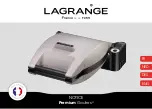
14
TROUBLESHOOTING GUIDE
No.
Problem
Cause
Solution
1
Smoke coming from
ventilation holes when
baking.
When used for the first time, oil
remained on the surface of heat
element will burn out, this is normal.
Use the bread maker in a
ventilated area, the smoke and
odour should disappear over
time.
2
Bread bottom crust is
too thick.
Keeping bread warm and leaving
bread in the bread pan for a long time
has caused loss of moisture in the
bread.
Take bread out immediately after
cooking without leaving it in keep
warm state.
3
It is very difficult to take
bread out.
Kneader adheres tightly to the shaft in
bread pan.
After taking bread out, pour hot
water into the bread pan and
leave the kneader immersed in
hot water for 10 minutes, then
remove to clean.
4
Stirred ingredients not
baked properly.
1.The selected cooking program is not
correct.
Select the proper program menu
2. When baking, the lid has been
opened several times and bread has
become dry. No brown crust colour.
Do not open the lid until the end
of the baking process.
3.Stir resistance is too high due to
thick mixture. This can prevent the
kneader from rotating properly and not
stir adequately.
Reduce the thickness of the
mixture by adding appropriate
amount of water. Also, reduce the
quantity of added ingredients, i.e.
honey, carrots.
5
Displays shows “H HH”
after
pressing
“
start/stop
” button.
The temperature in the bread maker is
too high or overheated.
Press “
start/stop
” button and
unplug bread maker, then take
the bread pan out and leave the
lid open until the bread maker
cools down.
6
Hear the motor noise
but dough isn’t stirred.
Bread pan is fixed incorrectly or dough
size is too large to be stirred.
Check to ensure the bread pan is
fixed properly and dough is
made according to the recipe
with correct weight and volume.
7
Bread size is so large
that it pushes the lids
Too much yeast or flour or water, or
outside temperature is too high.
Check the quantity of the
ingredients. Use the bread
maker in a cooler location.
8
Bread size is too small
or bread does not rise
Little to no yeast added. The
temperature of the water used is too
high or yeast is mixed together with
salt, or the environment temperature is
too low.
Adjust the quantity of the yeast
and water temperature.
9
Dough is so large that it
overflows out of the
bread pan.
Too much liquid and yeast been used,
making the dough soft causing to
overflow.
Reduce the amount of liquid and
yeast. This should make the
dough more rigid.
10
Bread collapses in the 1. Flour used is not strong enough and
does not make the dough rise.
Use good quality bread flour or
change the brand of flour.



































